light CHEVROLET CAMARO 1967 1.G Chassis Workshop Manual
[x] Cancel search | Manufacturer: CHEVROLET, Model Year: 1967, Model line: CAMARO, Model: CHEVROLET CAMARO 1967 1.GPages: 659, PDF Size: 114.24 MB
Page 7 of 659

GENERAL INFORMATION 0-5
Fig.
10—Delcotron Unit
Serial Number
Fig.
11—3-4 Speed Transmission Unit
Number Located on Lower Left Side of
Case Adjacent to Rear of Cover
(Saginaw)
Fig.
12-3 Speed Borg-Warner
Transmission Unit Number Located on
Boss Right Rear Comer of Extension
Fig.
13 — 4-Speed Transmission Source
Data Code is Located on Left Side of
Case at Lower Rear of Cover Flange
(Muncie)
Fig.
14—Starter Serial Number and
Production Date Stamped on Outer
Case,
Toward Rear
Fig.
15—Powerglide Transmission Unit
Number located on Right Rear Vertical
Surface of Oil Pan
16—The Turbo Hydra-Matic Transmission Serial Number
is Located on the Light Blue Plate
Location on the Right Side of the Transmission
tumbler, single bitted type having four tumblers. To
protect owners, automobile lock manufacturers stamp
the lock numbers on the lock core, shaft, etc., where they
will not show until lock is removed.
In addition, when a lock cylinder requires replacement
the lock code number may be obtained either from the
key, if available, or from old lock cylinder which is being
replaced.
Fig.
17—Battery Code Number Located on Cell
Cover Segment, Top of Battery
TUMBLERS
5 4 3 2 1
jjwvvvvvjl
SPRING RETAINER
Fig.
18-Side Bar Lock
CHEVROLET CHASSIS SERVICE MANUAL
Page 9 of 659
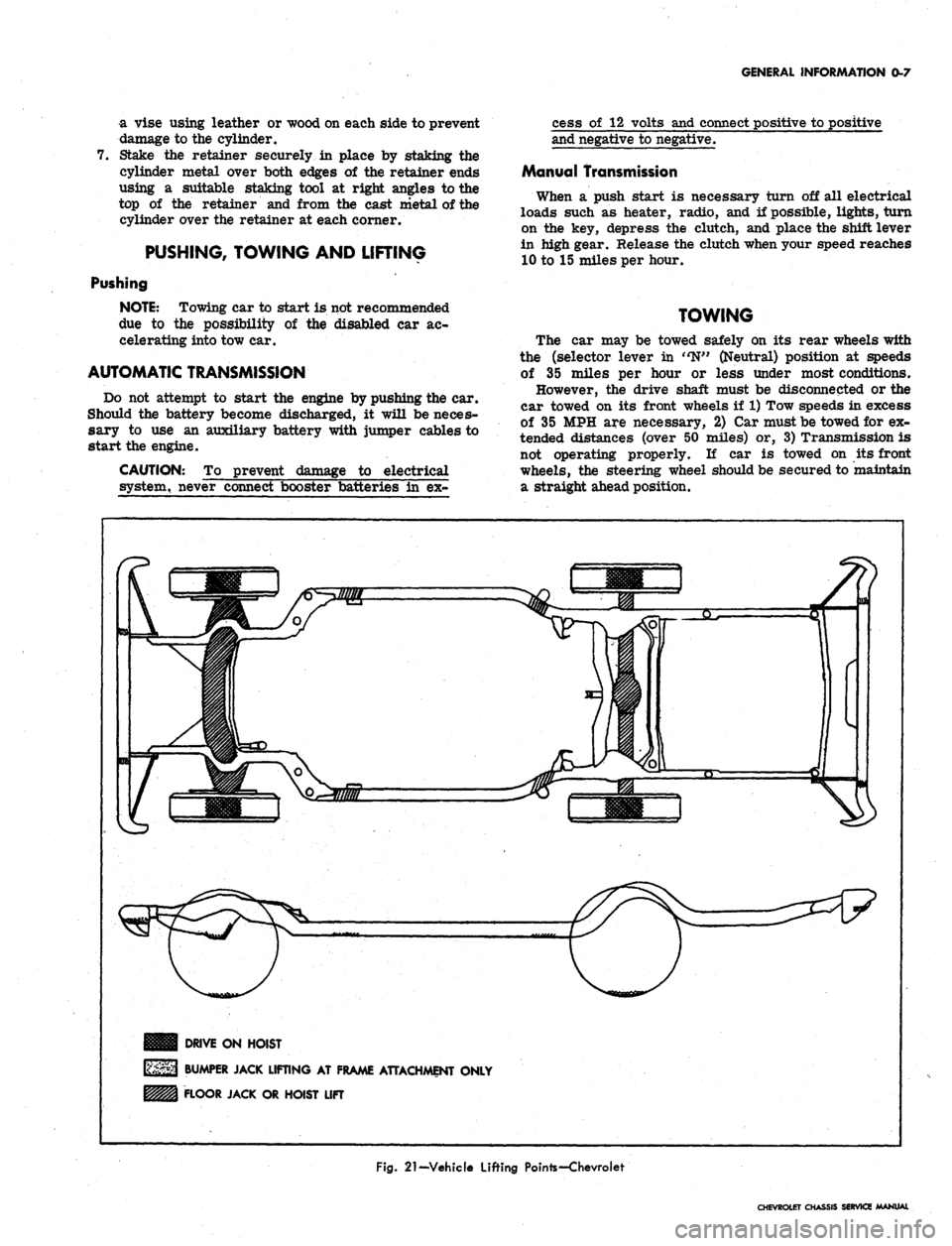
GENERAL INFORMATION 0-7
a vise using leather or wood on each side to prevent
damage to the cylinder,
7. Stake the retainer securely in place by staking the
cylinder metal over both edges of the retainer ends
using a suitable staking tool at right angles to the
top of the retainer and from the cast metal of the
cylinder over the retainer at each corner.
PUSHING, TOWING AND LIFTING
Pushing
NOTE:
Towing car to start is not recommended
due to the possibility of the disabled car ac-
celerating into tow car.
AUTOMATIC TRANSMISSION
Do not attempt to start the engine by pushing the car.
Should the battery become discharged, it will be neces-
sary to use an auxiliary battery with jumper cables to
start the engine.
CAUTION: To prevent damage to electrical
system, never connect booster batteries in ex-
cess of 12 volts and connect positive to positive
and negative to negative.
Manual Transmission
When a push start is necessary turn off all electrical
loads such as heater, radio, and if possible, lights, turn
on the key, depress the clutch, and place the shift lever
in high gear. Release the clutch when your speed reaches
10 to 15 miles per hour.
TOWING
The car may be towed safely on its rear wheels with
the (selector lever in "N" (Neutral) position at speeds
of 35 miles per hour or less under most conditions.
However, the drive shaft must be disconnected or the
car towed on its front wheels if 1) Tow speeds in excess
of 35 MPH are necessary, 2) Car must be towed for ex-
tended distances (over 50 miles) or, 3) Transmission is
not operating properly. If car is towed on its front
wheels, the steering wheel should be secured to maintain
a straight ahead position.
DRIVE ON HOIST
BUMPER JACK LIFTING AT FRAME ATTACHMENT ONLY
FLOOR JACK OR HOIST LIFT
Fig.
21-Vehicle Lifting Pointe-Chevroiet
CHEVROLET CHASSIS SERVICE MANUAL
Page 15 of 659
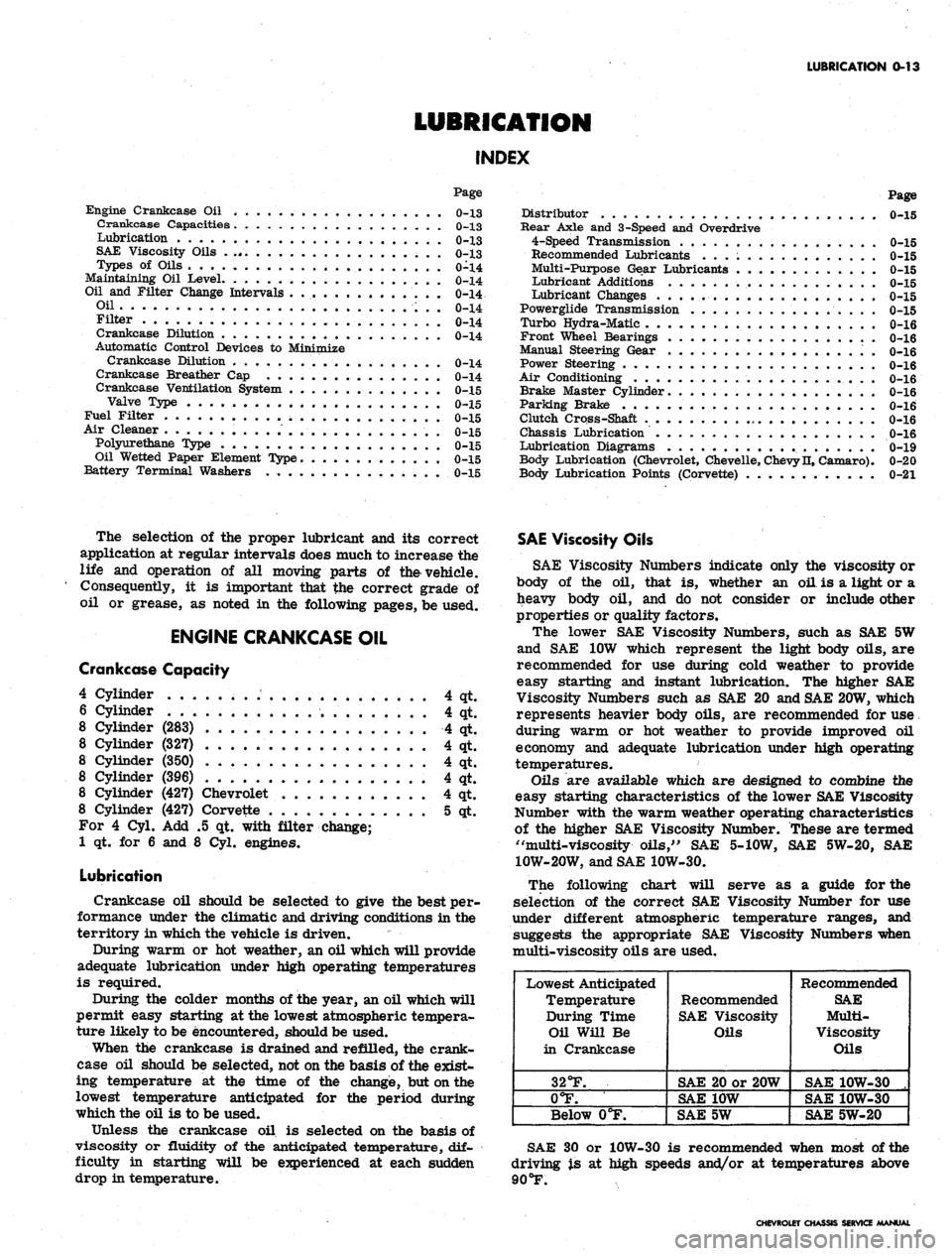
LUBRICATION 0-13
LUBRICATION
INDEX
Page
Engine Crankcase Oil . 0-13
Crankcase Capacities. . 0-13
Lubrication . ,
•
o-13
SAE Viscosity Oils 0-13
Types of Oils 0-14
Maintaining Oil Level 0-14
Oil and Filter Change Intervals 0-14
Oil.
. . ...:.. 0-14
Filter o-14
Crankcase Dilution . 0-14
Automatic Control Devices to Minimize
Crankcase Dilution 0-14
Crankcase Breather Cap 0-14
Crankcase Ventilation System 0-15
Valve Type 0-15
Fuel Filter 0-15
Air Cleaner . 0-15
Polyurethane Type 0-15
Oil Wetted Paper Element Type 0-15
Battery Terminal Washers 0-15
Page
Distributor 0-15
Rear Axle and 3-Speed and Overdrive
4-Speed Transmission 0-15
Recommended Lubricants 0-15
Multi-Purpose Gear Lubricants 0-15
Lubricant Additions 0-15
Lubricant Changes 0-15
Powerglide Transmission 0-15
Turbo Hydra-Matic 0-16
Front Wheel Bearings 0-16
Manual Steering Gear . . . . 0-16
Power Steering 0-16
Air Conditioning 0-16
Brake Master Cylinder. 0-16
Parking Brake 0-16
Clutch Cross-Shaft , 0-16
Chassis Lubrication 0-16
Lubrication Diagrams . . 0-19
Body Lubrication (Chevrolet, Chevelle, Chevy n, Camaro). 0-20
Body Lubrication Points (Corvette) . 0-21
The selection of the proper lubricant and its correct
application at regular intervals does much to increase the
life and operation of all moving parts of the vehicle.
Consequently, it is important that the correct grade of
oil or grease, as noted in the following pages, be used.
ENGINE CRANKCASE OIL
Crankcase Capacity
4 Cylinder 4 qt.
6 Cylinder 4 qt.
8 Cylinder (283) 4 qt.
8 Cylinder (327) 4 qt.
8 Cylinder (350) 4 qt.
8 Cylinder (396) 4 qt.
8 Cylinder (427) Chevrolet 4 qt.
8 Cylinder (427) Corvette 5 qt.
For 4 Cyl. Add .5 qt. with filter change;
1 qt. for 6 and 8 Cyl. engines.
Lubrication
Crankcase oil should be selected to give the best per-
formance under the climatic and driving conditions in the
territory in which the vehicle is driven.
During warm or hot weather, an oil which will provide
adequate lubrication under high operating temperatures
is required.
During the colder months of the year* an oil which will
permit easy starting at the lowest atmospheric tempera-
ture likely to be encountered, should be used.
When the crankcase is drained and refilled, the crank-
case oil should be selected, not on the basis of the exist-
ing temperature at the time of the change, but on the
lowest temperature anticipated for the period during
which the oil is to be used.
Unless the crankcase oil is selected on the basis of
viscosity or fluidity of the anticipated temperature, dif-
ficulty in starting will be experienced at each sudden
drop in temperature.
SAE Viscosity Oils
SAE Viscosity Numbers indicate only the viscosity or
body of the oil, that is, whether an oil is a light or a
heavy body oil, and do not consider or include other
properties or quality factors.
The lower SAE Viscosity Numbers, such as SAE 5W
and SAE 10W which represent the light body oils, are
recommended for use during cold weather to provide
easy starting and instant lubrication. The higher SAE
Viscosity Numbers such as SAE 20 and SAE 20W, which
represents heavier body oils, are recommended for use
during warm or hot weather to provide improved oil
economy and adequate lubrication under high operating
temperatures.
Oils are available which are designed to combine the
easy starting characteristics of the lower SAE Viscosity
Number with the warm weather operating characteristics
of the higher SAE Viscosity Number. These are termed
"multi-viscosity oils," SAE 5-10W, SAE 5W-20, SAE
10W-20W, and SAE 10W-30.
The following chart will serve as a guide for the
selection of the correct SAE Viscosity Number for use
under different atmospheric temperature ranges, and
suggests the appropriate SAE Viscosity Numbers when
multi-viscosity oils are used.
Lowest Anticipated
Temperature
During Time
Oil Will Be
in Crankcase
32°F.
0°F.
Below 0°F.
Recommended
SAE Viscosity
Oils
SAE 20 or 20W
SAE 10W
SAE 5W
Recommended
SAE
Multi-
Viscosity
Oils
SAE 10W-30 .
SAE 10W-30
SAE 5W-20
SAE 30 or 10W-30 is recommended when most of the
driving is at high speeds and/or at temperatures above
90
°F.
CHEVROLET CHASSIS SERVICE MANUAL
Page 23 of 659
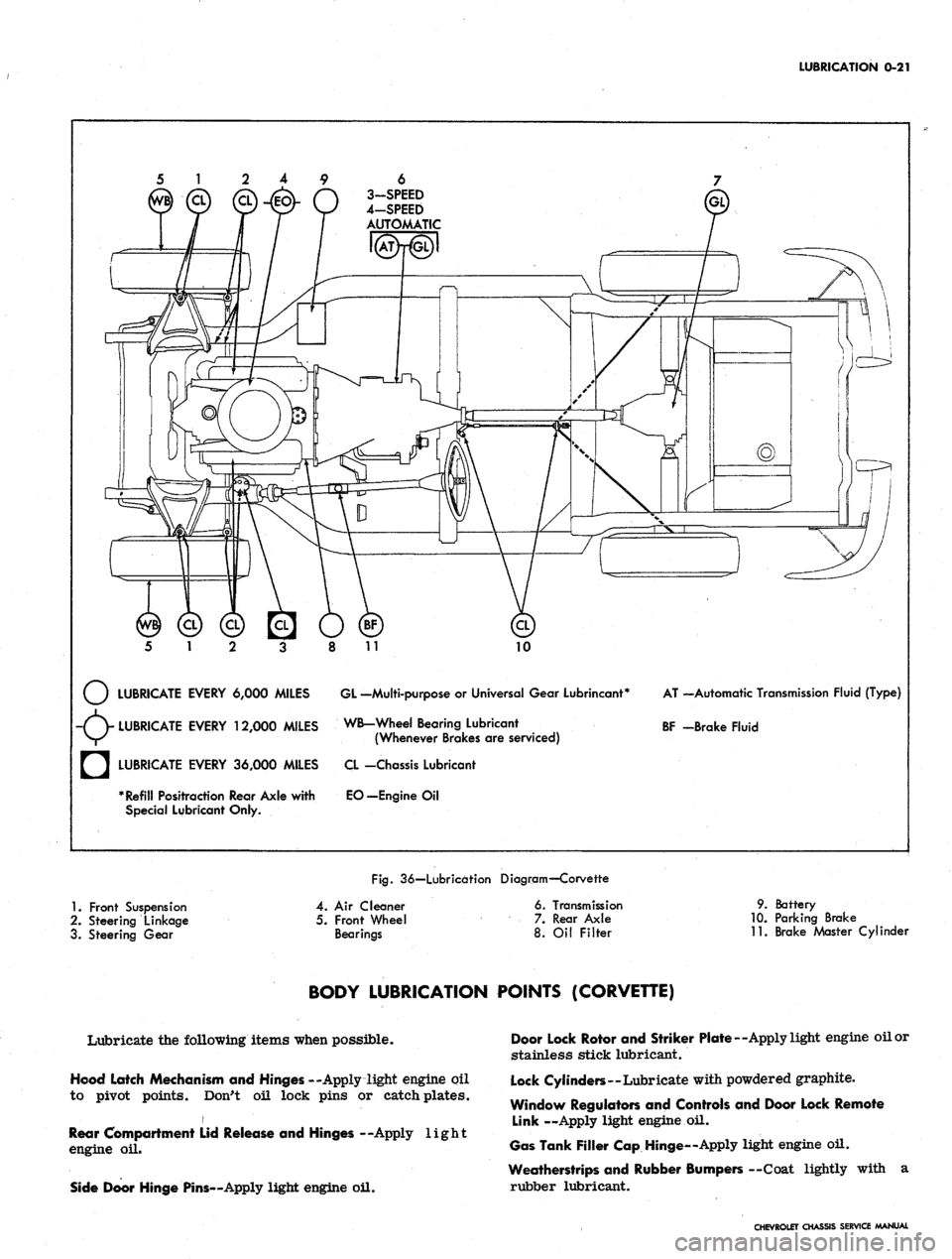
LUBRICATION
0-21
6
3-SPEED
4-SPEED
AUTOMATIC
10
LUBRICATE EVERY 6,000 MILES GL -Multi-purpose
or
Universal Gear Lubrincant*
-(V LUBRICATE EVERY 12,000 MILES WB-Wheel Bearing Lubricant
V/^ (Whenever Brakes
are
serviced)
AT —Automatic Transmission Fluid (Type)
BF -Brake Fluid
a
LUBRICATE EVERY 36,000 MILES
* Refill Positraction Rear Axle with
Special Lubricant Only.
CL -Chassis Lubricant
EO—Engine
Oil
Fig.
36—Lubrication Diagram—Corvette
1.
Front Suspension
2.
Steering Linkage
3. Steering Gear
4.
Air
Cleaner
5. Front Wheel
Bearings
6. Transmission
7. Rear Axle
8.
Oil
Filter
9. Battery
10.
Parking Brake
11.
Brake Master Cylinder
BODY LUBRICATION POINTS (CORVETTE)
Lubricate the following items when possible.
Hood Latch Mechanism and Hinges --Apply light engine oil
to pivot points. Don't oil lock pins or catch plates.
i
Rear Compartment Lid Release and Hinges --Apply light
engine
oil.
Side Door Hinge Pins—Apply light engine oil.
Door Lock Rotor and Striker Plate—Apply light engine oil or
stainless stick lubricant.
Lock Cylinders—Lubricate with powdered graphite.
Window Regulators and Controls and Door Lock Remote
Link —Apply light engine
oil.
Gas Tank Filler Cap Hinge—Apply light engine oil.
Weatherstrips and Rubber Bumpers —Coat lightly with
a
rubber lubricant.
CHEVROLET CHASSIS SERVICE MANUAL
Page 40 of 659
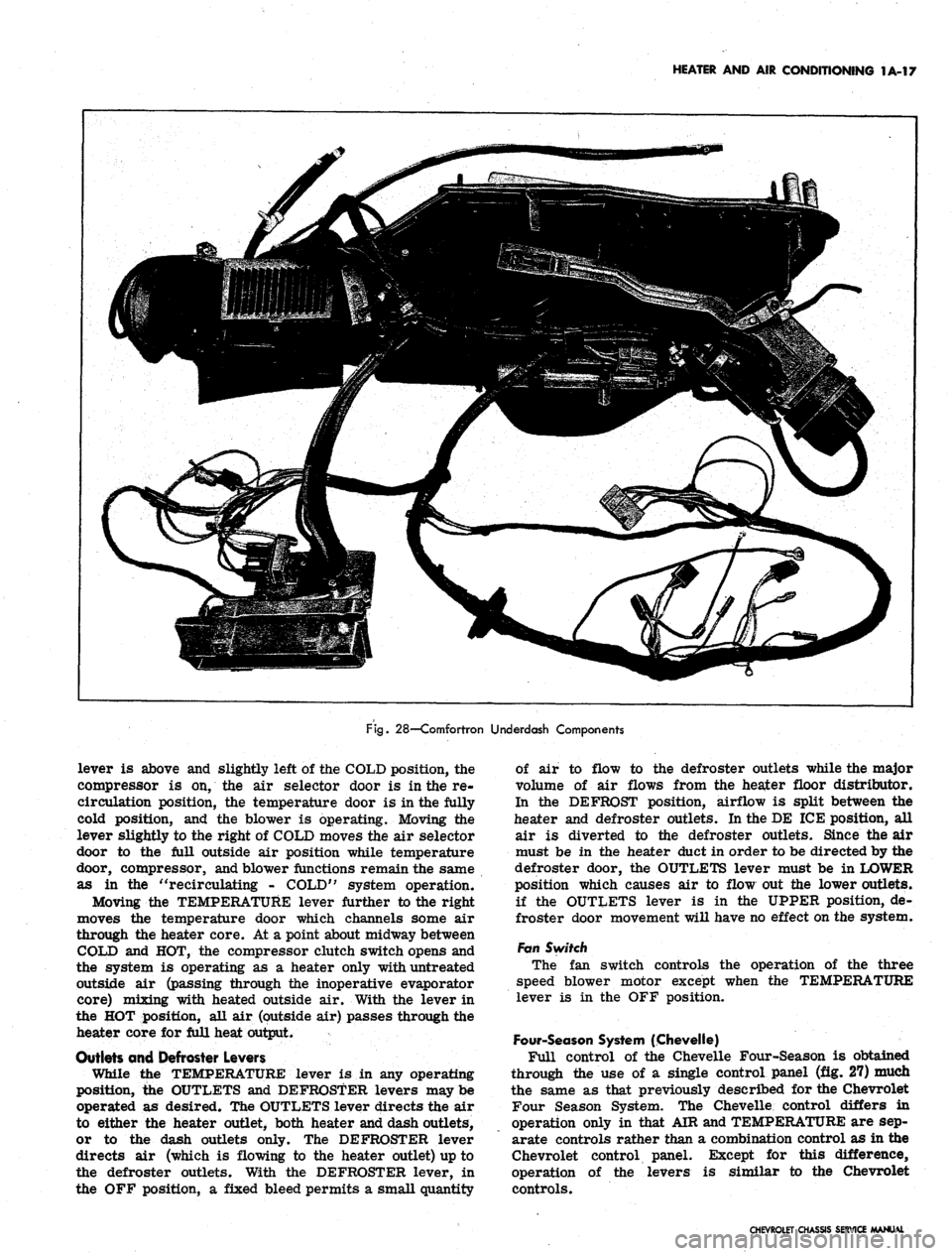
HEATER AND AIR CONDITIONING 1A-17
i
c
Fig.
28—Comfortron Underdash Components
lever is above and slightly left of the COLD position, the
compressor is on, the air selector door is in the re-
circulation position, the temperature door is in the fully
cold position, and the blower is operating. Moving the
lever slightly to the right of COLD moves the air selector
door to the full outside air position while temperature
door, compressor, and blower functions remain the same
as in the "recirculating - COLD" system operation.
Moving the TEMPERATURE lever further to the right
moves the temperature door which channels some air
through the heater core. At a point about midway between
COLD and HOT, the compressor clutch switch opens and
the system is operating as a heater only with untreated
outside air (passing through the inoperative evaporator
core) mixing with heated outside air. With the lever in
the HOT position, all air (outside air) passes through the
heater core for full heat output.
Outlets and Defroster Levers
While the TEMPERATURE lever is in any operating
position, the OUTLETS and DEFROSTER levers may be
operated as desired. The OUTLETS lever directs the air
to either the heater outlet, both heater and dash outlets,
or to the dash outlets only. The DEFROSTER lever
directs air (which is flowing to the heater outlet) up to
the defroster outlets. With the DEFROSTER lever, in
the OFF position, a fixed bleed permits a small quantity
of air to flow to the defroster outlets while the major
volume of air flows from the heater floor distributor.
In the DEFROST position, airflow is split between the
heater and defroster outlets. In the DE ICE position, all
air is diverted to the defroster outlets. Since the air
must be in the heater duct in order to be directed by the
defroster door, the OUTLETS lever must be in LOWER
position which causes air to flow out the lower outlets,
if the OUTLETS lever is in the UPPER position, de-
froster door movement will have no effect on the system.
Fan Switch
The fan switch controls the operation of the three
speed blower motor except when the TEMPERATURE
lever is in the OFF position.
Four-Season System (Chevelle)
Full control of the Chevelle Four-Season is obtained
through the use of a single control panel (fig. 27) much
the same as that previously described for the Chevrolet
Four Season System. The Chevelle control differs in
operation only in that AIR and TEMPERATURE are sep-
arate controls rather than a combination control as in the
Chevrolet control panel. Except for this difference,
operation of the levers is similar to the Chevrolet
controls.
CHEVROLET CHASSIS SERVICE MANUAL
Page 42 of 659

HEATER AND AIR CONDITIONING 1A-19
Transducer
The transducer will produce a vacuum output that is
completely adjustable by varying the input voltage which
is provided by the amplifier. An increase in the applied
voltage results in a reduced vacuum output.
Power Servo
The power servo receives a vacuum signal from the
transducer, and it is capable of assuming any position
that is called for by the sensors, amplifier, and trans-
ducer. The power servo performs the following functions:
1.
Positions the temperature mix door via the tern-
perature door link. The position of this door~"de-
termihes the portions of hot and cold air being
blended and discharged into the car.
2.
Operates the power servo vacuum valve which de-
termines the air flow paths for heating and air
conditioning.
3.
Contains a printed circuit board which controls the
blower speed. The power servo position determines
the blower speed, but the control lever switch can
override the blower program depending upon the
customer's preference.
4.
Contains the "Hi" blower delay thermistor and the
"master delay thermistor".
Outside Air Diaphragm
When there is no vacuum applied to the hose, the out-
side air door is closed under spring tension. With the
door closed, air is taken from the inside of the auto-
mobile and re-circulated. Applying vacuum to the dia-
phragm opens the door for outside air.
Mode Door Diaphragm
Located behind the duct work, the mode door diaphragm
directs the air flow out either the air conditioning outlets,
the heater floor outlet, or both the heater and air con-
ditioning outlets. This is a push-pull type diaphragm
actuated by vacuum through two hoses and controlled by
the power servo vacuum switch.
Defroster Door
The defroster door is in the defog position until vacuum
is applied to the actuator to obtain either full heat or full
de-ice position.
High Blower Delay Thermistor
The high blower delay thermistor is located on the
power servo housing under the power servo vacuum valve
and printed circuit board assemblies. The function of the
thermistor is to operate the blower at a reduced speed
when the control is in the HI FRONT position until the
residual cold air is discharged from the duct work. This
function occurs when the blower first comes "on" in cold
weather.
Vacuum Tank
During heavy acceleration, the vacuum supply from
the carburetor drops. The vacuum tank, using a^ check
valve, stores vacuum so that under these conditions
vacuum will be available for the Comfortron.
Thermal Vacuum Valve (Hot Water Vacuum Switch)
When engine coolant temperature reaches 75°F, the
valve opens and supplies vacuum to the outside air door
if the system is calling for outside air.
Master Delay Thermister
This thermistor delays the initial operation of the
blower when the system is in the heat mode. In cold
weather this allows outside ram air to flow through the
system thereby purging the cold air in the ducts gradually
until the coolant reaches about 105°F. Then, the termis-
tor passes enough current to energize the master delay
relay which powers the blower at about nine volts.
Vacuum Relay Valve
This relay valve will shut off transducer vacuum to the
power servo whenever the vacuum from the engine intake
manifold falls below the vacuum in the power servo
supply line (engine stopped or operating at low manifold
vacuum). This causes the power servo to be held in
position when the vacuum supply falls too low to maintain
servo control.
Vacuum Bleeder
A vacuum bleeder insures that the outside air door will
close (diaphragm will bleed down) after the system has
been shut down. This prevents outside air from entering
when starting the system on a cold day before the engine
coolant temperature reaches 75°F.
Sun—Ambient Sensor
The sun-ambient sensor measures the temperature of
the air entering the air intake grille in front of the wind-
shield. The sensor is exposed to sun light so that it can
lower the in-car temperature slightly when the sun
is shining.
Ambient Switch
The ambient switch operates the air conditioning com-
pressor clutch. When the outside temperature is above
40° F. the switch will be closed and the compressor will
be running. This switch is included as| part of the sun-
ambient sensor assembly, but operates independently.
Resistor Assembly
The blower resistors are located in the evaporator
housing. The printed circuit board switch in the power
servo determines which of the resistors is being used,
and as in conventional systems, the resistors control the
blower speed.
System Operation
When starting the Comfortron System in cold weather,
the following sequence of events occurs:
1.
Initially the system is inoperative. In LO FRONT
position the master delay thermistor is warming
(self-heating because current is flowing through it)
CHEVROLET CHASSIS SERVICE MANUAL
Page 51 of 659
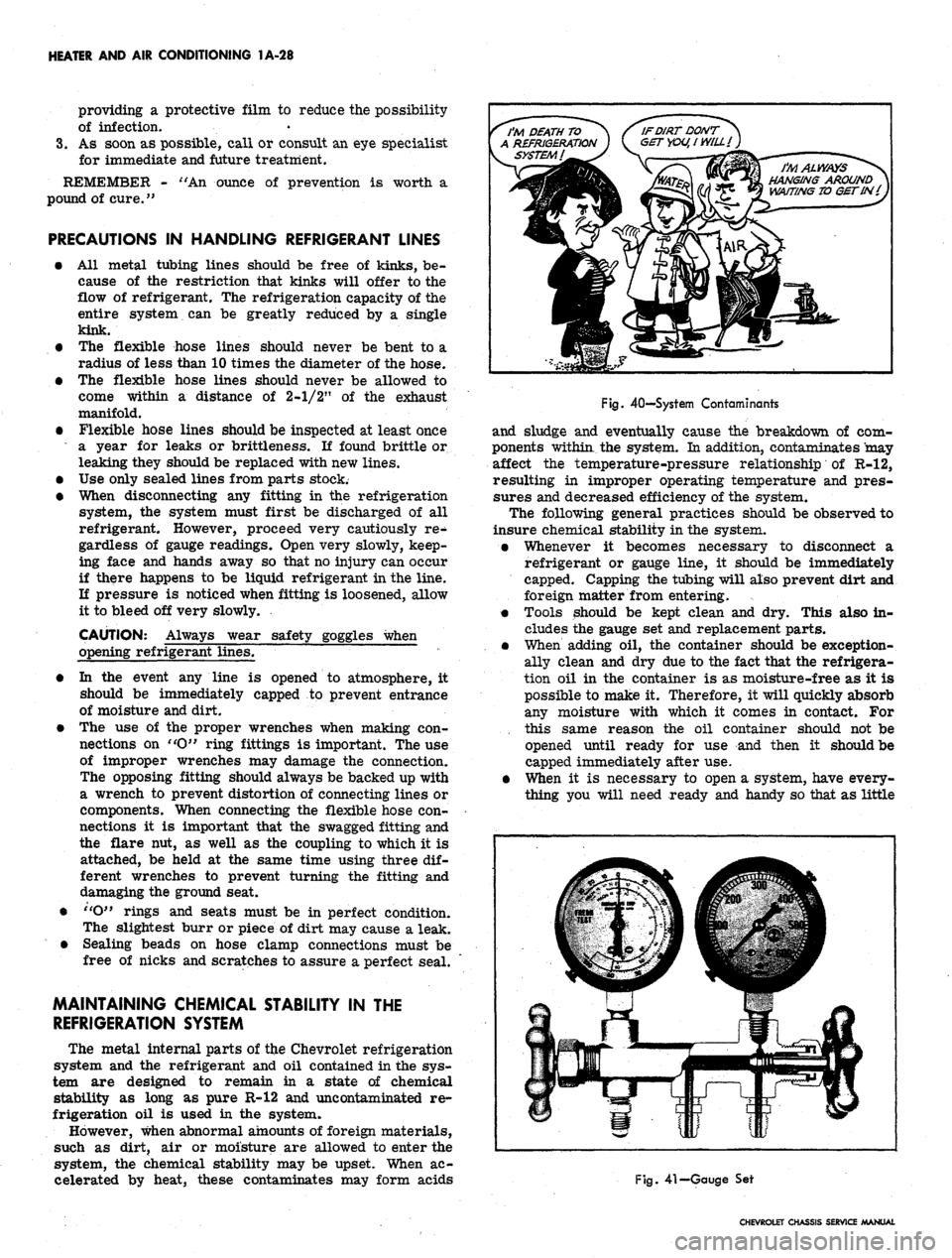
HEATER AND AIR CONDITIONING 1A-28
providing a protective film to reduce the possibility
of infection.
3.
As soon as possible, call or consult an eye specialist
for immediate and future treatment.
REMEMBER -
pound of cure."
"An ounce of prevention is worth a
PRECAUTIONS IN HANDLING REFRIGERANT LINES
• All metal tubing lines should be free of kinks, be-
cause of the restriction that kinks will offer to the
flow of refrigerant. The refrigeration capacity of the
entire system can be greatly reduced by a single
kink.
• The flexible hose lines should never be bent to a
radius of less than 10 times the diameter of the hose.
• The flexible hose lines should never be allowed to
come within a distance of 2-1/2" of the exhaust
manifold.
• Flexible hose lines should be inspected at least once
a year for leaks or brittleness. If found brittle or
leaking they should be replaced with new lines.
• Use only sealed lines from parts stock.
• When disconnecting any fitting in the refrigeration
system, the system must first be discharged of all
refrigerant. However, proceed very cautiously re-
gardless of gauge readings. Open very slowly, keep-
ing face and hands away so that no injury can occur
if there happens to be liquid refrigerant in the line.
If pressure is noticed when fitting is loosened, allow
it to bleed off very slowly.
CAUTION: Always wear safety goggles when
opening refrigerant lines.
• In the event any line is opened to atmosphere, it
should be immediately capped to prevent entrance
of moisture and dirt.
• The use of the proper wrenches when making con-
nections on "O" ring fittings is important. The use
of improper wrenches may damage the connection.
The opposing fitting should always be backed up with
a wrench to prevent distortion of connecting lines or
components. When connecting the flexible hose con-
nections it is important that the swagged fitting and
the flare nut, as well as the coupling to which it is
attached, be held at the same time using three dif-
ferent wrenches to prevent turning the fitting and
damaging the ground seat.
• "O" rings and seats must be in perfect condition.
The slightest burr or piece of dirt may cause a leak.
• Sealing beads on hose clamp connections must be
free of nicks and scratches to assure a perfect seal.
MAINTAINING CHEMICAL STABILITY IN THE
REFRIGERATION SYSTEM
The metal internal parts of the Chevrolet refrigeration
system and the refrigerant and oil contained in the sys-
tem are designed to remain in a state of chemical
stability as long as pure R-12 and uncontaminated re-
frigeration oil is used in the system.
However, when abnormal amounts of foreign materials,
such as dirt, air or moisture are allowed to enter the
system, the chemical stability may be upset. When ac-
celerated by heat, these contaminates may form acids
Fig.
40-^-System Contaminants
and sludge and eventually cause the breakdown of com-
ponents within, the system. In addition, contaminates may
affect the temperature-pressure relationship of R-12,
resulting in improper operating temperature and pres-
sures and decreased efficiency of the system.
The following general practices should be observed to
insure chemical stability in the system.
• Whenever it becomes necessary to disconnect a
refrigerant or gauge line, it should be immediately
capped. Capping the tubing will also prevent dirt and
foreign matter from entering.
• Tools should be kept clean and dry. This also in-
cludes the gauge set and replacement parts.
• When adding oil, the container should be exception-
ally clean and dry due to the fact that the refrigera-
tion oil in the container is as moisture-free as it is
possible to make it. Therefore, it will quickly absorb
any moisture with which it comes in contact. For
. this same reason the oil container should not be
opened until ready for use and then it should be
capped immediately after use.
• When it is necessary to open a system, have every-
thing you will need ready and handy so that as little
Fig.
41—Gauge Set
CHEVROLET CHASSIS SERVICE MANUAL
Page 53 of 659
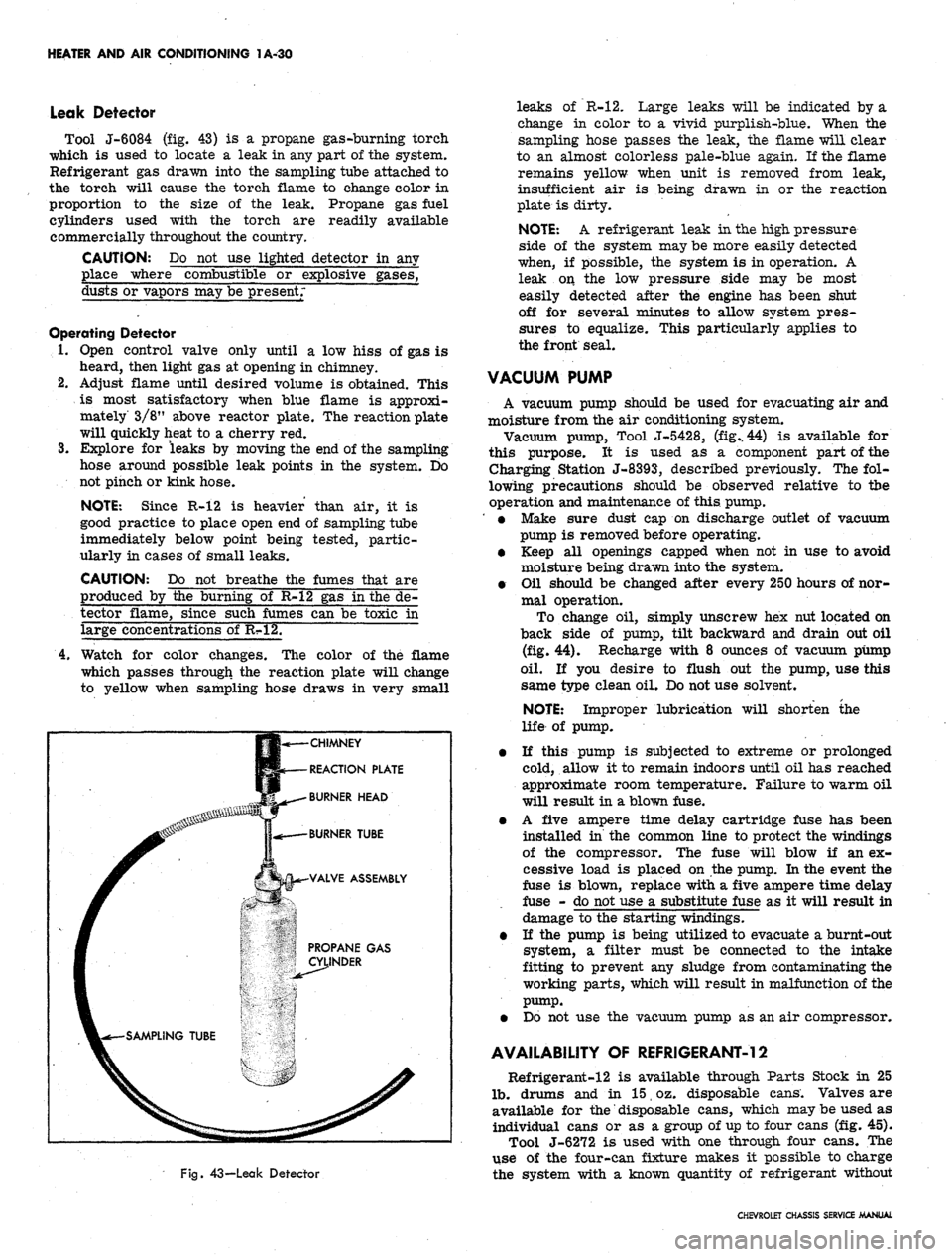
HEATER AND AIR CONDITIONING 1A-30
Leak Detector
Tool J-6084 (fig. 43) is a propane gas-burning torch
which is used to locate a leak in any part of the system.
Refrigerant gas drawn into the sampling tube attached to
the torch will cause the torch flame to change color in
proportion to the size of the leak. Propane gas fuel
cylinders used with the torch are readily available
commercially throughout the country.
CAUTION: Do not use lighted detector in any
place where combustible or explosive gases,
dusts or vapors may be present;
Operating Detector
1.
Open control valve only until a low hiss of gas is
heard, then light gas at opening in chimney.
2.
Adjust flame until desired volume is obtained. This
is most satisfactory when blue flame is approxi-
mately 3/8" above reactor plate. The reaction plate
will quickly heat to a cherry red.
3.
Explore for leaks by moving the end of the sampling
hose around possible leak points in the system. Do
not pinch or kink hose.
NOTE: Since R-12 is heavier than air, it is
good practice to place open end of sampling tube
immediately below point being tested, partic-
ularly in cases of small leaks.
CAUTION: Do not breathe the fumes that are
produced by the burning of R-12 gas in the de-
tector flame, since such fumes can be toxic in
large concentrations of R?»12.
4.
Watch for color changes. The color of the flame
which passes through the reaction plate will change
to yellow when sampling hose draws in very small
CHIMNEY
REACTION PLATE
BURNER HEAD
Fig.
43—Leak Detector
leaks of R-12. Large leaks will be indicated by a
change in color to a vivid purplish-blue. When the
sampling hose passes the leak, the flame will clear
to an almost colorless pale-blue again. If the flame
remains yellow when unit is removed from leak,
insufficient air is being drawn in or the reaction
plate is dirty.
NOTE: A refrigerant leak in the high pressure
side of the system may be more easily detected
when, if possible, the system is in operation. A
leak on the low pressure side may be most
easily detected after the engine has been shut
off for several minutes to allow system pres-
sures to equalize. This particularly applies to
the front seal.
VACUUM PUMP
A vacuum pump should be used for evacuating air and
moisture from the air conditioning system.
Vacuum pump, Tool J-5428, (fig.. 44) is available for
this purpose. It is used as a component part of the
Charging Station J-8393, described previously. The fol-
lowing precautions should be observed relative to tbe
operation and maintenance of this pump.
' • Make sure dust cap on discharge outlet of vacuum
pump is removed before operating.
• Keep all openings capped when not in use to avoid
moisture being drawn into the system.
• Oil should be changed after every 250 hours of nor-
mal operation.
To change oil, simply unscrew hex nut located on
back side of pump, tilt backward and drain out oil
(fig. 44). Recharge with 8 ounces of vacuum pump
oil.
If you desire to flush out the pump, use this
same type clean oil. Do not use solvent.
NOTE: Improper lubrication will shorten the
life of pump.
• If this pump is subjected to extreme or prolonged
cold, allow it to remain indoors until oil has reached
approximate room temperature. Failure to warm oil
will result in a blown fuse.
• A five ampere time delay cartridge fuse has been
installed in the common line to protect the windings
of the compressor. The fuse will blow if an ex-
cessive load is placed on the pump. In the event the
fuse is blown, replace with a five ampere time delay
fuse - do not use a substitute fuse as it will result in
damage to the starting windings.
• If the pump is being utilized to evacuate a burnt-out
system, a filter must be connected to the intake
fitting to prevent any sludge from contaminating the
working parts, which will result in malfunction of the
pump.
• Do not use the vacuum pump as an air compressor.
AVAILABILITY OF REFRIGERANT-12
Refrigerant-12 is available through Parts Stock in 25
lb.
drums and in 15 oz. disposable cans. Valves are
available for
the"
disposable cans, which may be used as
individual cans or as a group of up to four cans (fig. 45).
Tool J-6272 is used with one through four cans. The
use of the four-can fixture makes it possible to charge
the system with a known quantity of refrigerant without
CHEVROLET CHASSIS SERVICE MANUAL
Page 73 of 659
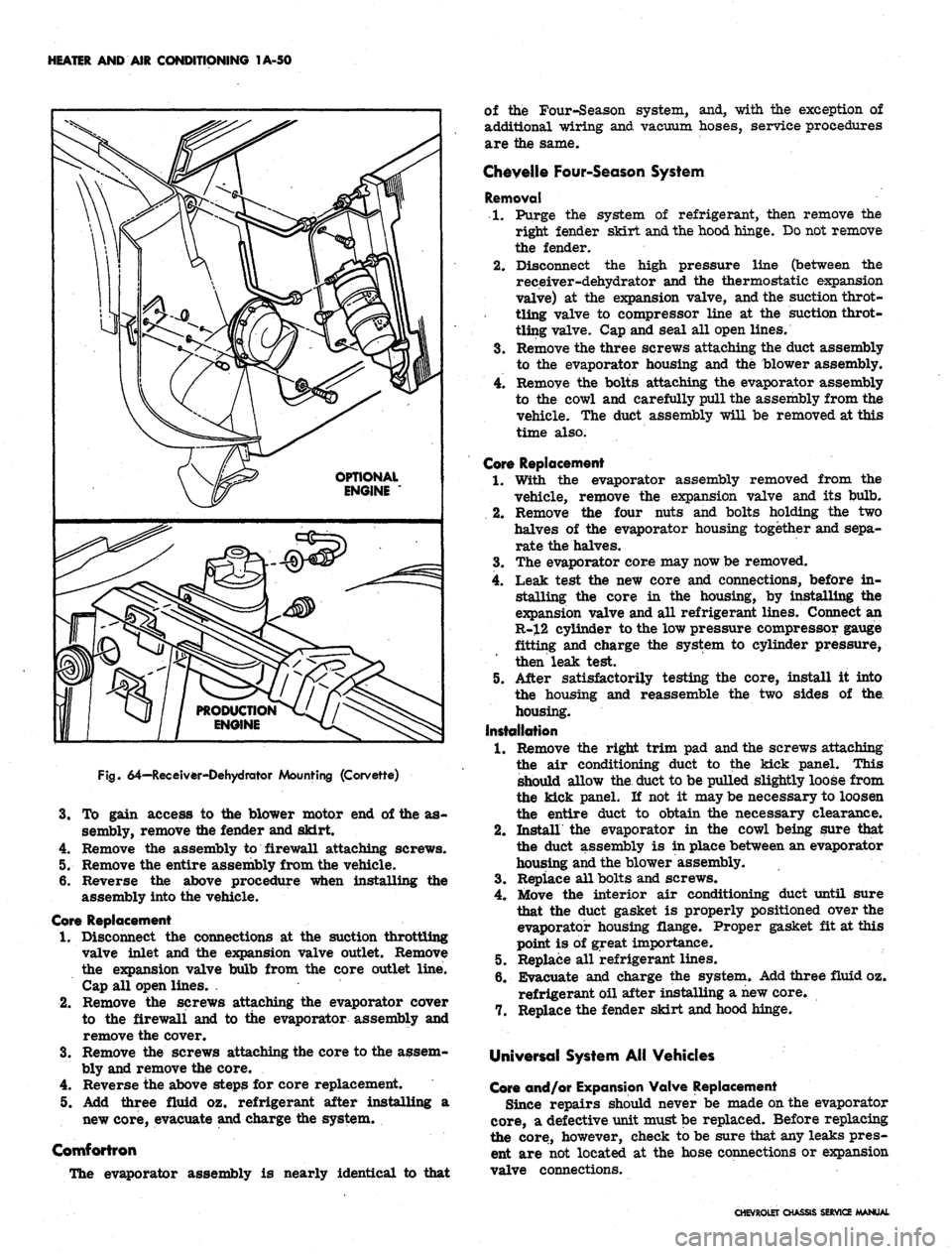
HEATER AND AIR CONDITIONING 1A-50
Fig.
64—Receiver-Dehydrator Mounting (Corvette)
3.
4.
5.
6.
To gain access to the blower motor end of the as-
sembly, remove the fender and skirt.
Remove the assembly to firewall attaching screws.
Remove the entire assembly from the vehicle.
Reverse the above procedure when installing the
assembly into the vehicle.
Core Replacement
1.
Disconnect the connections at the suction throttling
valve inlet and the expansion valve outlet. Remove
the expansion valve bulb from the core outlet line.
Cap all open lines. .
Remove the screws attaching the evaporator cover
to the firewall and to the evaporator assembly and
remove the cover.
Remove the screws attaching the core to the assem-
bly and remove the core.
Reverse the above steps for core replacement.
Add three fluid oz. refrigerant after installing a
new core, evacuate and charge the system.
2.
3.
4.
5.
Comfortron
The evaporator assembly is nearly identical to that
of the Four-Season system, and, with the exception of
additional wiring and vacuum hoses, service procedures
are the same.
Chevelle Four-Season System
Removal
•
1.
Purge the system of refrigerant, then remove the
right fender skirt and the hood hinge. Do not remove
the fender.
2.
Disconnect the high pressure line (between the
receiver-dehydrator and the thermostatic expansion
valve) at the expansion valve, and the suction throt-
tling valve to compressor line at the suction throt-
tling valve. Cap and seal all open lines.
3.
Remove the three screws attaching the duct assembly
to the evaporator housing and the blower assembly.
4.
Remove the bolts attaching the evaporator assembly
to the cowl and carefully pull the assembly from the
vehicle. The duct assembly will be removed at this
time also.
Core Replacement
1.
With the evaporator assembly removed from the
vehicle, remove the expansion valve and its bulb.
2.
Remove the four nuts and bolts holding the two
halves of the evaporator housing together and sepa-
rate the halves.
3.
The evaporator core may now be removed.
4.
Leak test the new core and connections, before in-
stalling the core in the housing, by installing the
expansion valve and all refrigerant lines. Connect an
R-12 cylinder to the low pressure compressor gauge
fitting and charge the system to cylinder pressure,
then leak test.
5. After satisfactorily testing the core, install it into
the housing and reassemble the two sides of the.
housing.
Installation
1.
Remove the right trim pad and the screws attaching
the air conditioning duct to the kick panel. This
should allow the duct to be pulled slightly loose from
the kick panel. If not it may be necessary to loosen
the entire duct to obtain the necessary clearance.
2.
Install the evaporator in the cowl being sure that
the duct assembly is in place between an evaporator
housing and the blower assembly.
3.
Replace all bolts and screws.
4.
Move the interior air conditioning duct until sure
that the duct gasket is properly positioned over the
evaporator housing flange. Proper gasket fit at this
point is of great importance.
5. Replace all refrigerant lines.
6. Evacuate and charge the system. Add three fluid oz.
refrigerant oil after installing a new core.
7. Replace the fender skirt and hood hinge.
Universal System All Vehicles
Core and/or Expansion Valve Replacement
Since repairs should never be made on the evaporator
core, a defective unit must be replaced. Before replacing
the core, however, check to be sure that any leaks pres-
ent are not located at the hose connections or expansion
valve connections.
CHEVROLET CHASSIS SERVICE MANUAL
Page 87 of 659
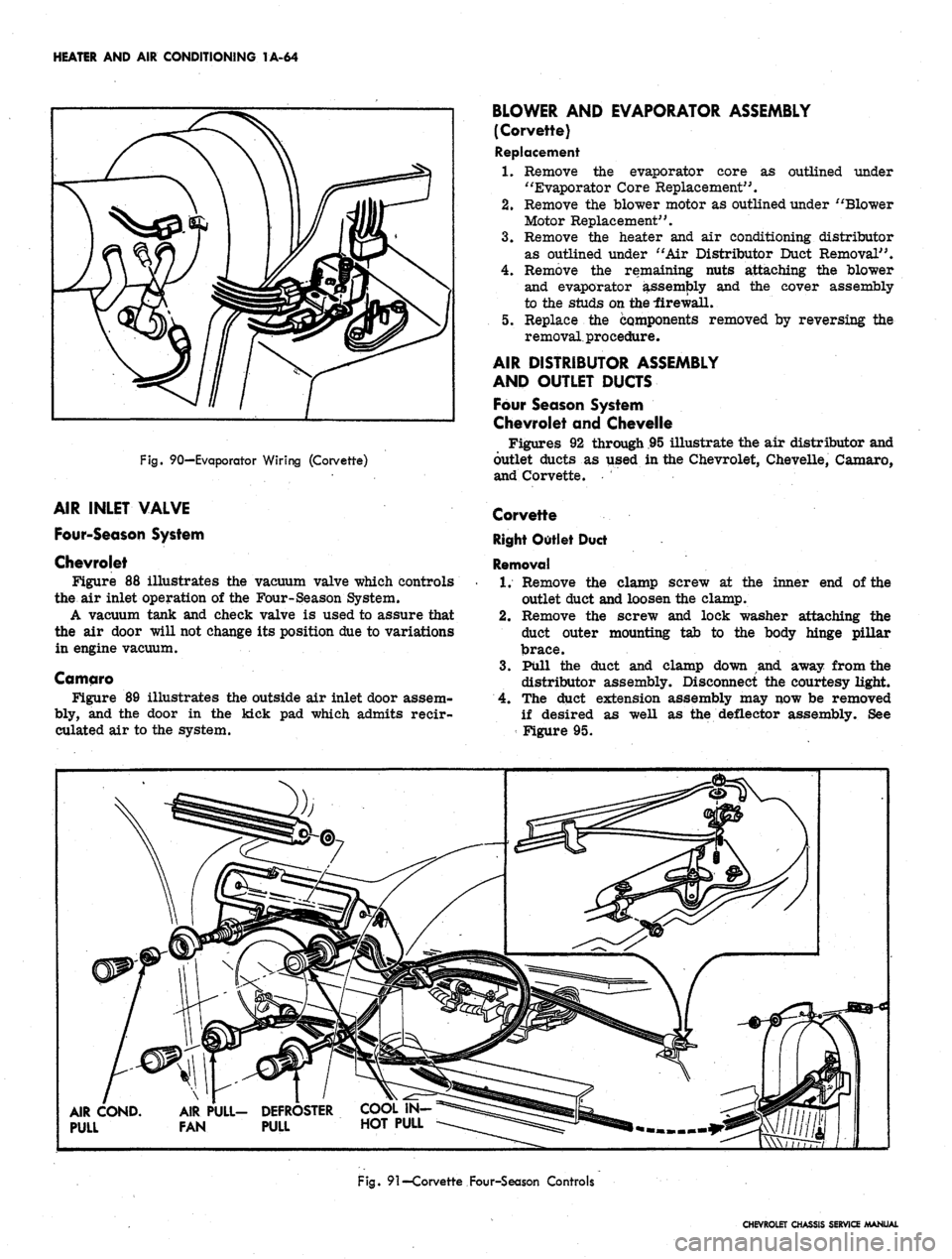
HEATER AND AIR CONDITIONING 1A-64
Fig.
90—Evaporator Wiring (Corvette)
AIR INLET VALVE
Four-Season System
Chevrolet
Figure 88 illustrates the vacuum valve which controls
the air inlet operation of the Four-Season System.
A vacuum tank and check valve is used to assure that
the air door will not change its position due to variations
in engine vacuum.
Camqro
Figure 89 illustrates the outside air inlet door assem-
bly, and the door in the kick pad which admits reeir-
culated air to the system.
BLOWER AND EVAPORATOR ASSEMBLY
(Corvette)
Replacement
1.
Remove the evaporator core as outlined under
"Evaporator Core Replacement".
2.
Remove the blower motor as outlined under "Blower
Motor Replacement".
3.
Remove the heater and air conditioning distributor
as outlined under "Air Distributor Duct Removal".
4.
Remove the remaining nuts attaching the blower
and evaporator assembly and the cover assembly
to the studs on the -firewall.
5. Replace the components removed by reversing the
removal, procedure.
AIR DISTRIBUTOR ASSEMBLY
AND OUTLET DUCTS
Four Season System
Chevrolet and Chevelle
Figures 92 through .95 illustrate the air distributor and
outlet ducts as used in the Chevrolet, Chevelle, Camaro,
and Corvette.
Corvette
Right Outlet Duct
Removal
1.
Remove the clamp screw at the inner end of the
outlet duct and loosen the clamp.
2.
Remove the screw and lock washer attaching the
duct outer mounting tab to the body hinge pillar
brace.
3.
Pull the duct and clamp down and away from the
distributor assembly. Disconnect the courtesy light.
4.
The duct extension assembly may now be removed
if desired as well as the deflector assembly. See
Figure 95.
AIR COND.
PULL
AIR PULL- DEFROSTER
FAN PULL HOT PULL
Fig.
91—Corvette Four-Season Controls
CHEVROLET CHASSIS SERVICE MANUAL